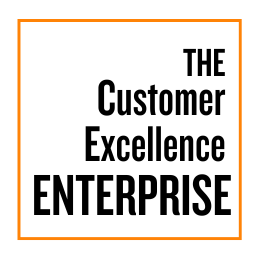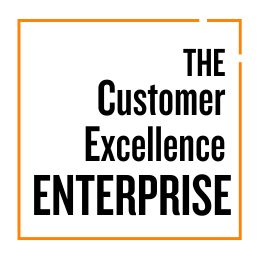
The Customer Excellence Enterprise: A Playbook for Creating Customers for Life,
[PART 3] Five Essential Shifts to Renew the CMO and Marketer Value Proposition
[Part 3]: The Future of Marketing is Customer-Centric: Five Essential Shifts to Renew the CMO and Marketer Value Proposition
REFERENCE: “The Customer Excellence Enterprise: A Playbook for Creating Customers for Life”: Chapter 10: Reimagining Commercial DNA
Five Essential Shifts to Renew the CMO and Marketer Value Proposition
How can CMOs and Marketers renew their value proposition amid significant change and disruption by Experiential Commerce, AI and the democratization of marketing tech?
In The Future of Marketing is Customer-Centric (PART 3), we build on the fundamental question: Are CMOs, Marketers and Marketing Disposable? that we explored in Part 2 by going in-depth about the 5 essential shifts that CMOs and Marketers can make towards a Customer-Centric Marketing paradigm.
Synopsis. The macroeconomic shift to Experiential Commerce, combined with the rise of the AI replacement narrative and the democratization of digital marketing technology, is redefining the role of CMOs and marketers in real time. This moment presents both a challenge and an unprecedented opportunity:
- Are the machines really coming for our marketing jobs?
- Will contemporary marketing playbooks—rooted in differentiating product features and functions, brand storytelling, and campaign-driven engagement—still be sufficient in a world where customer experience outliers companies keep resetting the bar?
- How will increasing exposure to personalized, frictionless, and emotionally resonant experiences from customer experience outliers shape evolving customer expectations?
- How can CMOS and marketers seize the opportunity, rather than succumb to the threat?
With the structural implications of these major forces, CMOs and marketers must redefine their strategic value proposition by championing a DNA-level transformation that extends beyond the traditional remit of the marketing discipline. Yet, true transformation can feel daunting, even paralyzing, as it requires rethinking entrenched assumptions, breaking down silos, and challenging the status quo.
Accordingly, despite years of discussion, many companies have yet to close the gap between talking about customer centricity and actually embedding it into their DNA. The responsibility—and opportunity—to bridge this divide now falls to CMOs and marketers. Stepping up beyond their traditional execution-focused commercial remit, they must lead a broader transformation that redefines how their companies view, value and treat customers. This shift isn’t just about elevating marketing; it’s about reshaping the entire enterprise to align closer to customers and create sustained competitive advantage.
Whether it’s reimagining the retail experience (as Nike does with its House of Innovation) or embedding digital convenience into the customer journey (**as Starbucks has with mobile ordering and rewards**) success in Experiential Commerce hinges on marketing’s ability to influence not just customer perception, but their lived reality. Fortunately, as a guiding light, this journey has been mastered by today’s customer excellence enterprises, those perennial performance outliers that win not just by promoting their products and telling compelling stories, but also by ensuring their promises come to life in every interaction.
(**How the Starbucks mastery of mobile order has impacted the in-store experience is another story for another day!**)
The macroeconomic shift to Experiential Commerce, combined with the rise of the AI replacement narrative and the democratization of digital marketing technology, is redefining the role of CMOs and marketers in real time. This moment presents both a challenge and an unprecedented opportunity—not just for marketing, but for how companies define and measure value itself. This Customer Excellence Transformation is not without form, it is anchored in five essential shifts that CMOs, modern marketers, along with customer experience professionals must collectively facilitate to future-proof their organizations and careers paths.
SHIFT #1. From Tangible to Intangible Value Exchange.
As the modern customer increasingly prioritizes intangible elements of value, Experiential Commerce is reshaping not only customer expectations but also how CFOs and capital markets assess value creation or destruction potential. This evolution is neither anecdotal nor transient; it is structural and customer-led. According to the World Bank, the global economy has steadily transitioned from an industrial, tangible product-based model to an intangible value exchange, now accounting for over 65% of global GDP and more than 75% of GDP in high-income countries (World Bank, 2023). For CMOs and marketers, this shift presents a massive opportunity: by embracing intangible value exchange, they can expand the dimensions of their brand’s core propositions and position their companies as indispensable partners in customers’ lives. Customer Excellence Enterprises like Airbnb, Starbucks, and Tesla have already proven the case, demonstrating that value is no longer just about what or how a company sells, but about how it integrates into customers’ daily lives—creating ongoing relevance, emotional loyalty, and sustained differentiation. As capital markets increasingly reward companies that deliver on these intangible drivers, CMOs who step up to lead this transformation won’t just redefine marketing’s role; they’ll influence how their companies are valued and positioned for long-term growth.
How to get started on Shift #1. Collaborate with CFOs to quantify the impact of experiential factors on financial outcomes, such as premium pricing, customer stickiness, and reduced churn.
SHIFT #2. From a Campaign-Centric to Customer-Centric Marketing Model.
Experiential commerce in particular is a forcing function for CMOs and marketers to reevaluate the status quo and undergo a paradigm shift—moving from a campaign-centric to a customer-centric marketing model. Marketing has revolved around promotional campaigns, often operating in a hit-or-miss cycle of awareness, promotional and demand generation that prioritizes acquisition and short-term sales spikes over sustained engagement. This “launch and leave” approach leaves enormous untapped value on the table. A customer-centric mindset, in contrast, does not reject campaigns but repositions them within a broader, more holistic strategy—one where marketing is not just about selling but about building meaningful, ongoing relationships. This shift tempers the instinctive over-reliance on promotions with a deeper focus on experience as an organic and enduring component of the value proposition. This evolution requires that marketing move beyond episodic interactions and instead become a steward of the entire customer lifecycle, ensuring that every touchpoint reinforces trust, loyalty, and differentiation.
How to get started on Shift #2. A Lifecycle Mapping Workshop forces marketing teams to step out of the campaign mindset and see the brand through the eyes of the customer. It helps marketers break free from the “launch and leave” cycle of promotional campaigns and instead design experiences that drive continuous engagement, retention, and expansion.
SHIFT #3. Experiential Factors as Equal Partners to Product and Brand Factors in Value Propositions.
The formula 3 < 2 represents a fundamental shift in competitive strategy—recognizing that companies that compete on product, brand, and experience unlock greater opportunities for customer value and differentiation than those that rely solely on the traditional product-brand paradigm. In this new conception, experience is no longer an afterthought or a “nice-to-have” enhancement; it is an equal pillar in shaping customer perceptions, driving preference, and fostering long-term loyalty. Product features and brand reputation may attract initial interest, but it is the experience—how seamlessly, intuitively, and emotionally a company engages with customers—that cements relationships and sustains competitive advantage. Industry leaders such as Apple, Tesla, and Ritz-Carlton have demonstrated that when experience is woven into the value proposition alongside product and brand, it becomes a key differentiator that commands premium pricing, increases retention, and fuels organic advocacy. CMOs and marketers must integrate experience as a core element of customer strategies rather than a secondary support function, future-proofing both their market position and career paths.
How to get started on Shift #3. Move beyond traditional marketing KPIs (impressions, clicks, conversions) to include experiential metrics like customer value-at-risk, emotional engagement scores, and experience-driven retention rates.
SHIFT #4. Evolving from a Transactional to a Relationship-Based Mindset
Another core attribute of the shift to customer-centric marketing is to move beyond transactional interactions to cultivate enduring relationships. Although this shift is as much about organizational mindset as anything, it is best expressed through measurement—marketers must go beyond transaction-based campaign metrics, such as click-through rates and conversions that measure marketing performance at a tactical level. While these metrics provide valuable insights into the effectiveness of campaigns, they fail to capture the broader financial impact and intricate value story of marketing relative to customer acquisition cost (CAC). For this, customer-centric marketing becomes the rationale to layer in Customer Lifetime Value (CLV) as a strategic metric. CLV provides a forward-looking view of a customer’s long-term value, enabling marketers to assess whether acquisition costs align with projected returns. Furthermore, understanding the causal relationships that drive CLV—such as customer satisfaction, retention rates, and upsell pull through—helps marketers make targeted interventions that move the needle and calibrate strategies with an eye on maximizing lifetime profitability.
How to get started on Shift #4: Integrate CLV as a core strategic metric alongside traditional campaign performance indicators, and identify the key drivers to ensure that acquisition costs align with long-term customer value, making smarter investments that prioritize enduring relationships over short-term wins.
SHIFT #5. Delivering Value Across the Entire Customer Lifecycle
A key feature of this Customer Excellence transformation is rebalancing the marketer’s remit and resource allocation across the entire customer lifecycle. Too often, marketing strategies can over-index on customer acquisition at the front-end of the customer lifecycle, viewing it almost as the exclusive engine of growth while neglecting the untapped potential of customer retention and expansion "beyond the funnel”. Experiential Commerce challenges this mindset by emphasizing the need to provide differentiated value throughout the entire customer lifecycle. Retention becomes more than preventing churn; it involves consistently delivering value, surprising and delighting customers to integrate into their daily routines and workflows. Expansion, in turn, means unlocking organic opportunities to deepen relationships through natural upselling and cross-selling pathways, grounded in the customer’s known, unknown and ever-evolving needs (the functional variety as well as their societal and emotional counterparts. This more holistic full-lifecycle approach ultimately aligns to the very human desire for customers to seek the comfort and assurance that comes from finding a select few companies to integrate into their lives as trusted partners.
How to get started on Shift #5: A critical first step for CMOs and marketers is to first measure to identify imbalance, then rebalance strategies and resources across the entire customer lifecycle as needed to drive customer value and commercial success.
Customer-Centricity is Winning.
Companies that have embraced this customer-centric philosophy, including “the usual suspects”— Chewy, Amazon, The Four Seasons, Singapore Airlines, Zappos, etc. —and countless others exemplify how a customer and experience-infused value proposition can fuel a customer acquisition, retention, and expansion flywheel of elevated revenue performance and sustained growth. Their success is rooted in designing and delivering seamless, personalized, and emotionally resonant interactions that align to customer preferences, meet customer needs and often provide moments of “wow” to them. For CMOs and marketers, the challenge is clear: to lead their companies in building similar Customer Excellence Enterprises and brand-aligned experience delivery systems that make a clear break from any lingering perceptions that marketing is a cost center rather than an indispensable enabler of enduring customer relationships and outsized success.
Key Takeaways for CMOs and Marketers
- With intangible services and experiences becoming the dominant source of value to customers, CMOs must redefine their strategies to align with this new customer reality.
- Marketing must evolve beyond episodic campaigns designed to generate short-term sales and instead become a continuous engagement engine that fosters emotional connections that enhance revenue performance, retention, and expansion.
- Winning companies integrate marketing into the entire customer journey, ensuring value is consistently delivered.
- The traditional product-brand paradigm is no longer sufficient for sustainable differentiation. Companies that embed experiential factors as an organic pillar of their value proposition create stronger customer connections, higher retention, and pricing power. CMOs must champion this strategic shift.
- CMOs must lead their companies to move beyond one-time conversions to delivering sustained value and emotional engagement throughout the customer lifecycle.
- Marketing has traditionally focused on acquisition, leaving retention and expansion underdeveloped. Future-proof CMOs must extend their impact beyond the funnel, driving customer success, advocacy, and lifetime value by integrating marketing into customer excellence disciplines—engagement, success, experience management, and customer care.
Readiness Questions to Consider
- How well does our marketing strategy reflect the shift from tangible to intangible value?
- Does marketing operate in isolated, campaign-driven bursts, or is it deeply embedded in the entire customer lifecycle, ensuring customer value beyond promotions?
- Do we treat customer experience as a separate discipline from marketing, or is it an equal strategic pillar to product and brand?
- Are we still measuring success through transactional KPIs, or do we track relationship-driven metrics?
- Are we only engaging customers pre-sale, or do we play a meaningful role in post-purchase engagement, customer success, and retention building initiatives?
To learn more, order
“The Customer Excellence Enterprise: A Playbook for Creating Customers for Life”
at all major booksellers.











